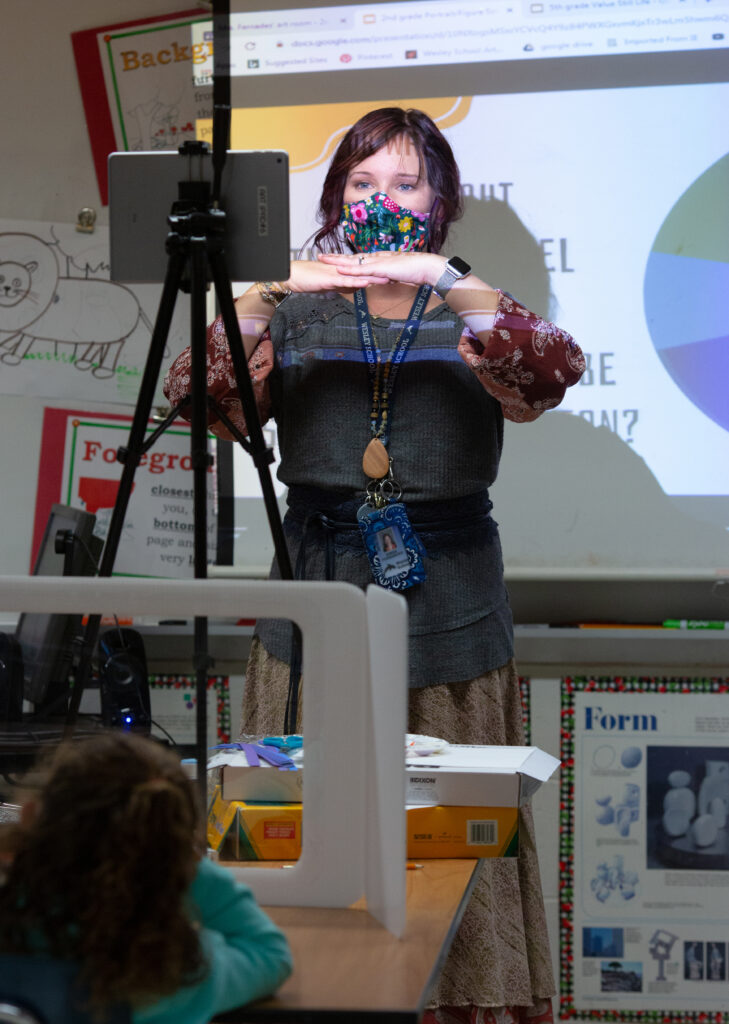“We spend time every day recharging our phones but often go months without recharging ourselves. If we have learned nothing over the past year, it is that we must recharge ourselves as well.”
-Thomas C. Murray, Director of Innovation, Future Ready Schools®

The year 2020 definitely was not a drill. However, if you watch former President Obama’s 2014 announcement of Future Ready Schools® (FRS), which included the ConnectED initiative for putting high-speed internet into more regions and households, the COVID-19 pandemic seemed like the coming storm to which he was alluding when he urged superintendents to prepare their learning communities for the future. As Obama said then, “… in a country where we expect free Wi-Fi with our coffee, the least we can do is expect that our schools are properly wired.”
Even if it took us six years and a pandemic to respond, we witnessed-and in some cases embraced-a near-mandatory and immediate shift to “learning from home” for all schools in the country. Last year showed that educators can adjust instructional practices rapidly while demonstrating an amazing amount of resilience and strength.
If we pause for a moment, we see a new kind of resilience through reflecting in motion. We know we cannot stop or control disruptions, but when our resources continue to be stretched thin, we can fail more gracefully by finding space to reflect and celebrate undeniable challenges we have all endured. While we work and plan for the next school year and beyond, we must take time to reflect upon our wins and gains, as this is what bolsters our resilience.In spite of all the ways the pandemic disrupted our work as educators, mountains of research data will continue to flood in until experts understand the multivariate impact to the field for both those working as K-12 educational professionals and the students who lost time working toward their goals and ultimately graduation.
As we take a breath and reflect, several themes are demanding our resilience to yield potential for our learners, for their families, and for our profession.
No Matter What: Three Lessons Learned that We Must Keep
1. Equity for All Learners
A full year after the death of George Floyd ignited a call for civil rights to finally be fulfilled, the urgent need for change has underscored the systemic inequities in schools and districts that many educators have been wrestling with for years. Namely, that our historically-underserved students stand little chance to conquer the opportunity gap without sincere and deliberate interventions that transcend what a school and/or district is able to provide. Fortunately for these teachers-and more so for the families they serve-a paradigm shift is emerging. There is an influx of federal and state funding to support these interventions as well as a call for a comprehensive review of our curricula to ensure that anti-bias and antiracist perspectives continue to ring out.
Investments in diversity, equity, and inclusion (DEI) have been quickly made in schools and districts across the country. Published statements of anti bullying have become even more specific; educators of color have been promoted into roles such as director of DEI for their districts; and curriculum teams are looking for ways to replace outdated textbooks and other learning materials.
Yet equity in education has a broader thrust to include developing capacity with even more district- and school-level staff members to address causal issues, from identifying a possible learning disability in the classroom to understanding how issues at home, such as neglect, abuse, or poverty, are impeding a learner’s progress.
Equity for all learners goes beyond establishing policies and their conventions, such as the familiar and legally binding individualized education plans (IEPs) or 504 plans. Equity appears in scheduling and staffing choices, discipline policies, and even meal plans. Meeting basic needs lays the foundation for all learners to succeed, which entails having better insight into what occurs longitudinally as we collaborate to work with each student.
The right tools can illuminate insight. A solid learning management system with the right inputs and visibility can help staff members obtain a more fully-orbed picture of how a student is engaging in learning, when they fall off, and if observations can be discreetly shared with staff members (as well as the student and family, when appropriate). From there, teachers and administrators can suss out causality for disengagement of students or guardians and when relevant, apply a tested intervention or refer students to additional services with precision and efficiency. In aggregate, this results in a more level playing field for all enrolled students, portends retention and graduation rates, and chips away at the gap between our more affluent students and those striving learners.
2. Social and Emotional Learning for Everyone in the Learning Community
For all the ground gained by social and emotional learning (SEL) in recent years, the COVID-19 pandemic has pushed the need for whole-child care to the forefront of services that our schools are prioritizing. For nearly a year, there are reports of both direct and indirect traumas endured by our learners. Data showed that unfinished learning will not be recovered if the child’s other needs have gone unattended (Durlak & Mahoney, 2019). Murray says, “Districts that want to increase student achievement should start by increasing support for SEL.” (Murray, 2019)
Mary Gilbert, principal of Tullahoma City Schools (TN), celebrates how SEL finally earned its prominence. She worked with her team to prioritize SEL and then shared her team’s journey during a May 2021 FRS event. Her reflections make a valid case for all other school and district leaders to aspire for the sort of results her staff and students have enjoyed while attending to the needs of the whole child and building a resilient culture from which any learning community can benefit.
Normalizing the need for emotional supports and the potential to design learning activities that bolster interpersonal skill development has been occurring at a rapid clip. It is borne out of necessity and comes out of strife that broke loose on several interrelated fronts in 2020. Although it has been building for a while, our field’s culture still is largely focused on what students need rather than on what students and teachers need.
As education leaders, we should agree that what is best for our learners must first be held and practiced in support of our teachers and administrators. The Collaborative for Academic, Social, and Emotional Learning’s (CASEL’s) extensive work as the vanguard on the topic is universal in their identified competencies for students, which include the following:
- Self-awareness
- Self-management
- Social awareness
- Relationship skills
- Responsible decision making
Please consider this question: How can you, as an education leader, put supports in place for your adult lead learners who guide your students toward the same self-actualization? If this question resonates with you, review the other SEL links in the organizer at the bottom of this post.
Prior to the pandemic, researchers were already noticing educators gearing up to administer treatments for needs they had not yet cared for. In a 2019 story published by McGraw-Hill, the authors referenced such research, stating the following about educator stressors:
“While stress is influenced by a variety of factors, research suggests that teacher stress is often caused by intense job demands, unsatisfactory relationships to school culture, and feelings of a lack of agency and autonomy in decision-making (Greenburg, et. al. 2016).”
Even though in most cases, our current structure for school counseling is committed to using funding to increase aptitude, materials, and support processes for addressing SEL (and by doing so, these supports often are embedded in academic work), what’s lacking are mechanisms akin to doctors healing themselves. Teachers need community, training, and interventions to safeguard depletion of their emotional and mental wellbeing. If we want to affect systemic change for the entire learning community, addressing the source of our children’s trauma in the household is a community service that will create a return on the investment into perpetuity.
We need to implement a culture that cares for the practitioners as well as students incorporated into our professional learning and even our historic expectations from the teacher’s job description.
3. Anytime, Anywhere Learning Happens Within the Learner, Not the School
Veterans of high-quality virtual schools or programs (regardless of mode) know that the past school year was a shakedown of their theories for how learning transpires. For years, nothing has been more important to a student’s growth and their educational outcomes than their relationships with their teachers, but that is not necessarily tantamount to that instructional exchange happening inside a brick-and-mortar classroom. For the YouTube generation, these relationships can develop and grow remotely, effectively, and at a pace that traditional full-time, direct classroom instruction cannot achieve.
Learning on demand is following the evolution of many creative industries and is no longer reliant upon physical structures for distributing or experiencing content. Just as we all enjoy music, movies, podcasts, books, and forms of storytelling and art in new distribution models without relying solely on a store or theater to consume that content, last year proved that the education field has the technology but lacks the training and mindset to transition many of our experiences with parity.
This extends beyond convenience and is about avoiding the pitfalls other reluctant fields were slow to address, such as when Airbnb and Vrbo disrupted hospitality and when Uber and Lyft disrupted personalized public transportation. These companies reoriented their business models to cater to the individual’s experience and attract them as customers with a more valuable experience. Putting the customer first created a successful transition to a new paradigm that did not exclude the outgoing one. The music industry figured this out as well by including a free digital copy with the purchase of a vinyl LP, promoting the most nostalgic form from the analog era without competing for the desire of music lovers to take those same songs with them when they are away from their turntables.
Like those in entertainment, hospitality, and transportation, educators still can embrace the incoming paradigm, harness the energy and what matters most-sparking learning and witnessing it in how our students express their insight-but that learning does not have to happen inside physical classrooms to be valid. In turn, we need new ways of assessing these practices followed by new ways of celebrating what we witness in each and every student.
Included below are some valuable links to keep you current with other fields’ breakthroughs in how to use technology to disrupt the status quo. We hope they will be useful to your own implementation, because when we do implement shrewdly and with fidelity, our learning experiences and learning spaces can be redesigned to be inclusive and innovative so that families in all communities can benefit from positive and equitable experiences for their children.
Now It’s Your Turn to Reflect in Motion, No Matter What
In what ways did you lean on your resilience or observe it in your schools that deserve to be reflected upon as you prepare yourself for the 2021-22 school year launch?

Download the Reflecting in Motion Organizer, grab a cup of coffee, and find a quiet space to spend 15 minutes reflecting. Think about the positive points first and then the lessons learned. Consider sharing these reflections with a colleague with whom you have worked closely over the past year. Do your reflections align? Are you in sync for moving forward? Are you more interested in the questions than the answers? Stay curious and creative. Share your reflections with the FRS network on social media using #FutureReady.
We want to hear your stories and encourage everyone to support each other.
The blog is supported by our partners at Desire2Learn.
